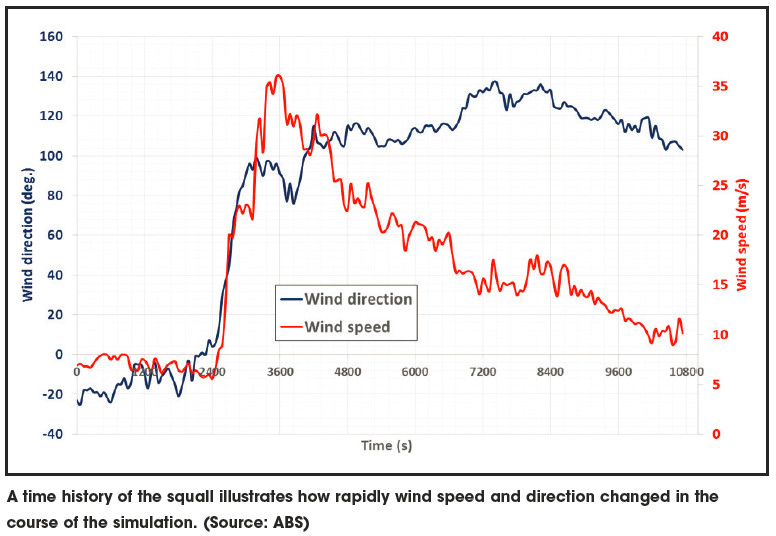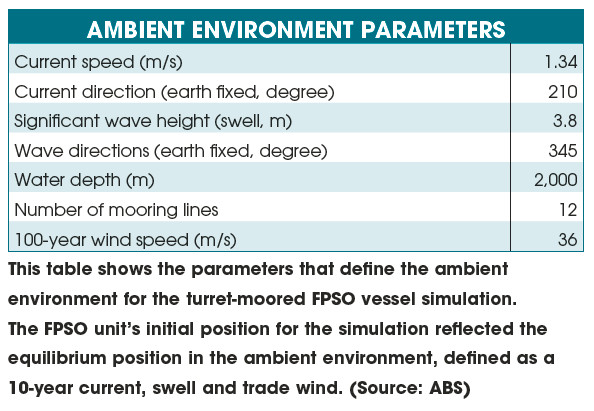Turret-mooring systems are being used today in a broad range of operating environments from Atlantic Canada, Brazil and Australia to the South China Sea. These systems are subjected to environmental forces that affect their motions and, in some instances, their stability.
The primary components of a turret-mooring system are the turret system, which is integrated inside or outside the vessel, and a mooring system that anchors the turret column to the seabed. The value of this type of system is that it contains a bearing system that allows the vessel to swivel around the fixed part of the turret so that it experiences the least resistance from waves, wind and currents. The ability to weathervane makes deployment possible in harsh environments and in areas that experience multidirectional environmental loading. A vessel that can weathervane offers more predictable offloading.
The heading of a turret-mooring vessel is dynamic and, as a result, presents challenges to engineers carrying out mooring-system response assessment. Most research to date has focused on the slow motions in the horizontal plane, particularly on the yaw motions (left to right movement around the turret).
For operating environments that have steady-state current, wind and wave direction, the analysis methods employed to date might be adequate, but for environments subject to squall conditions, where there are dramatic changes of wind speed and wind direction, another approach to analyzing the transient responses of the mooring system could be necessary. To date mooring system analysis has focused on mean equilibrium heading and low-frequency yaw motions, leaving transient behavior during the weathervaning process relatively unaddressed.

Defining the parameters
A squall is defined as a sudden sharp increase in wind speed, usually associated with active weather conditions like rain or thunderstorms. While squalls are characterized by an increase in sustained winds over a short time interval, it is important to note that there can be high gusts of wind as well.
In 2004 the West Africa Gust joint industry project (JIP) was initiated to record measurement of squalls and to get a better understanding of squall conditions. Over the next 10 years participants worked together, making the best use of available industry data for squall characterization in engineering design and analyzing measurements to define detailed squall characteristics. Although there is still uncertainty regarding squall characteristics, there now are more squall data records available for use in offshore structure design assessment.
Unfortunately, there is still a lack of consensus on how the squall records should be used for mooring system assessment, how ambient environment conditions should be defined, the number of squalls that should be analyzed or how the maximum mooring for the design should be determined.

Evaluating assessments
To help the industry improve understanding of how squalls affect turret-moored vessels, engineers at ABS evaluated the weathervaning performance of a turret-moored FPSO system under various environmental conditions. The objective was to study weathervaning on a turret-moored FPSO unit, including damping effects on yaw motions. To perform the evaluation, engineers carried out a number of simulations with turret-mooring systems using typical environmental conditions offshore West Africa. The primary goal of the study was to understand the behavior of a turret-moored FPSO subject to various loading scenarios, paying particular attention to the characteristics of the squall and its effects in combination with other environmental conditions.
Researchers performed time domain numerical simulations for a generic internal turret-moored FPSO unit using typical environmental conditions offshore West Africa with winds considered as the dominant environment condition and current and waves considered as ambient environments.
In outlining the test parameters, engineers selected a squall time series with a peak of 100-year wind speed at a given location. The squall’s direction is defined as the direction when wind speed is at the peak. The mooring system used in the study included three mooring line groups, each with four mooring lines. The FPSO unit’s initial position for the time domain simulation was assumed at the equilibrium position in the ambient environment, defined as a 10-year current, swell and trade wind. It is in the resultant force direction of current, swell and wind.
Often, when the initial squall heading is in the region of the stern (0 degrees to 90 degrees), the FPSO unit experiences a beam-on wind. Simulations show that the chance of the FPSO unit having both beam-on and maximum wind speed is very low. Using constant wind speed for the simulations can result in a very high transient mooring load. While yaw damping of the FPSO unit reduces the turret excursions, there is no clear indication of the effect of yaw damping on the mooring load.
In squall conditions mooring systems face more challenges than they do in steady-state wind conditions. Using time-domain numerical simulations to study turretmoored FPSO behavior, engineers discovered a number of interesting things.
First among these is that wind speed is the most important parameter, especially in the early stages of the squall when the turret-moored FPSO unit is weathervaning, changing from its initial heading to face into the weather head-on. Wind speed also is the most important parameter impacting mooring system response. Simulation results showed that the maximum mooring line load occurs when wind speed is at its peak, irrespective of the orientation of the FPSO unit. The rate of wind direction change—regardless of wind speed—does not seem to have much influence.
Further research
While the results of this study provide increased understanding of the response of turret-moored FPSO units in squall conditions, there are additional areas that require further study, including the treatment of transient response, response-based analysis vs. analysis based on design squalls, and studies that further investigate squall characteristics. An increase in the availability of squall records and increased mooring system monitoring will result in greater transparency between the response of the mooring system and a squall event, which will provide further help on the improvement of mooring assessment in squalls.
Through its participation in additional JIPs and joint development projects (JDPs), ABS is contributing to industry efforts to improve mooring system design, inspection, maintenance and operations. The JIPs and JDPs address subjects that include studies of mooring chain out-of-plane bending, fatigue performance of mooring chains in seawater, seawater corrosion of rope and chain, fatigue and strength assessment of corroded chain, mooring component assessment, Arctic mooring, floating production and storage vessel mooring integrity, and dynamically installed piles. Findings will be incorporated in an upcoming ABS Rules and Guides that will help the industry achieve safer mooring operations.
Recommended Reading
Baker Hughes: US Drillers Add Oil, Gas Rigs for Third Week in a Row
2025-02-14 - U.S. energy firms added oil and natural gas rigs for a third week in a row for the first time since December 2023.
Blackstone Buys NatGas Plant in ‘Data Center Valley’ for $1B
2025-01-24 - Ares Management’s Potomac Energy Center, sited in Virginia near more than 130 data centers, is expected to see “significant further growth,” Blackstone Energy Transition Partners said.
Huddleston: Haynesville E&P Aethon Ready for LNG, AI and Even an IPO
2025-01-22 - Gordon Huddleston, president and partner of Aethon Energy, talks about well costs in the western Haynesville, prepping for LNG and AI power demand and the company’s readiness for an IPO— if the conditions are right.
Cummins, Liberty Energy to Deploy New Engine for Fracking Platform This Year
2025-01-29 - Liberty Energy Inc. and Cummins Inc. are deploying the natural gas large displacement engine developed in a partnership formed in 2024.
US Drillers Add Oil, Gas Rigs for First Time in Eight Weeks
2025-01-31 - For January, total oil and gas rigs fell by seven, the most in a month since June, with both oil and gas rigs down by four in January.
Comments
Add new comment
This conversation is moderated according to Hart Energy community rules. Please read the rules before joining the discussion. If you’re experiencing any technical problems, please contact our customer care team.



